Astro Pi upgrades on the International Space Station
In 2015, The Raspberry Pi Foundation built two space-hardened Raspberry Pi units, or Astro Pis, to run student code on board the International Space Station (ISS).
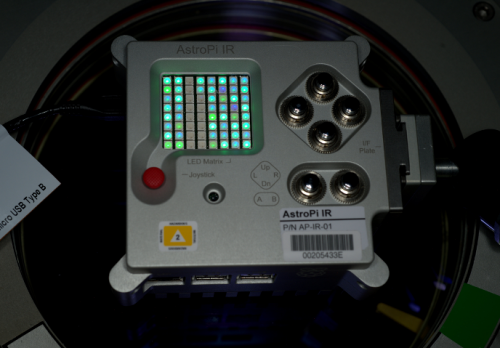
A space-hardened Raspberry Pi
Astro Pi upgrades
Each school year we run an Astro Pi challenge to find the next generation of space scientists to program them. After the students have their code run in space, any output files are downloaded to ground and returned to them for analysis.
That download process was originally accomplished by an astronaut shutting down the Astro Pi, moving its micro SD card to a crew laptop and copying over the files manually. This used about 20 minutes of precious crew time.
https://gfycat.com/gifs/detail/TautCreamyDwarfmongoose
Last year, we passed the qualification to allow the Astro Pi computers to be connected to the Local Area Network (LAN) on board the ISS. This allows us to remotely access them from the ground, upload student code and download the results without having to involve the crew.
This year, we have been preparing a new payload to upgrade the operational capabilities of the Astro Pi units.
The payload consists of the following items:
- 2 × USB WiFi dongles
- 5 × optical filters
- 4 × 32GB micro SD cards
Before anyone asks – no, we’re not going outside into the vacuum of space!
USB WiFi dongle
Currently both Astro Pi units are located in the European Columbus module. They’re even visible on Google Street View (pan down and right)! You can see that we’ve created a bit of a bird’s nest of wires behind them.
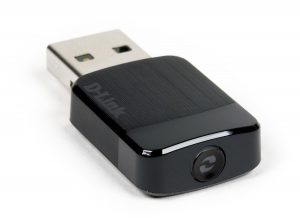
The D-Link DWA-171
The decision to add WiFi capability is partly to clean up the cabling situation, but mainly so that the Astro Pi units can be deployed in ISS locations other than the Columbus module, where we won’t have access to an Ethernet switch.
The Raspberry Pi used in the Astro Pi flight units is the B+ (released in 2014), which does not have any built in wireless connectivity, so we need to use a USB dongle. This particular D-Link dongle was recommended by the European Space Agency (ESA) because a number of other payloads are already using it.
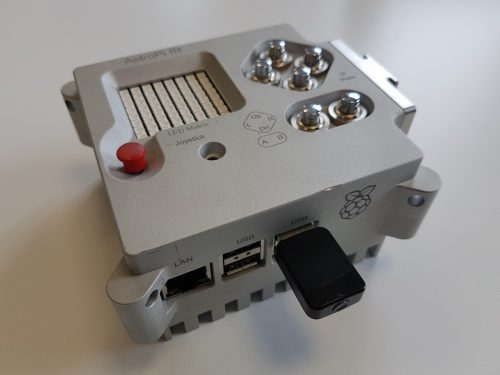
An Astro Pi unit with WiFi dongle installed
Plans have been made for one of the Astro Pi units to be deployed on an Earth-facing window, to allow Earth-observation student experiments. This is where WiFi connectivity will be required to maintain LAN access for ground control.
Optical filters
With Earth-observation experiments in mind, we are also sending some flexible film optical filters. These are made from the same material as the blue square which is shipped with the Pi NoIR camera module, as noted in this post from when the product was launched. You can find the data sheet here.
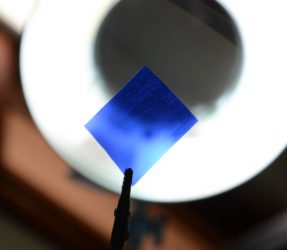
Rosco Roscalux #2007 Storaro Blue
To permit the filter to be easily attached to the Astro Pi unit, the film is laser-cut to friction-fit onto the 12 inner heatsink pins on the base, so that the camera aperture is covered.
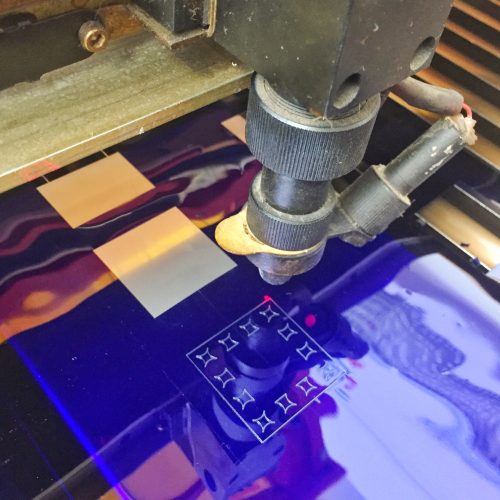
Laser cutting at Makespace
The laser-cutting work was done right here in Cambridge at Makespace by our own Alex Bate, and local artist Diana Probst.
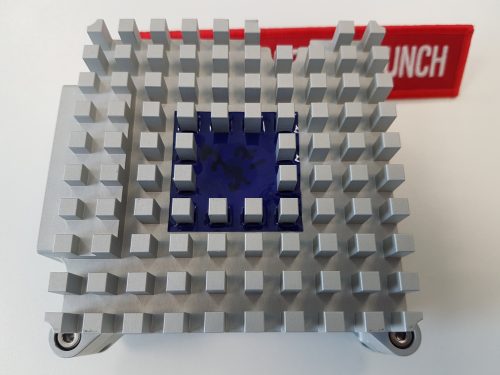
An Astro Pi with the optical filter installed
32GB micro SD cards
A consequence of running Earth observation experiments is a dramatic increase in the amount of disk space needed. To avoid a high frequency of commanding windows to download imagery to ground, we’re also flying some larger 32GB micro SD cards to replace the current 8GB cards.
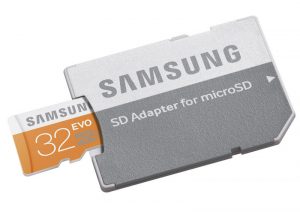
The Samsung Evo MB-MP32DA/EU
This particular type of micro SD card is X-ray proof, waterproof, and resistant to magnetism and heat. Operationally speaking there is no difference, other than the additional available disk space.
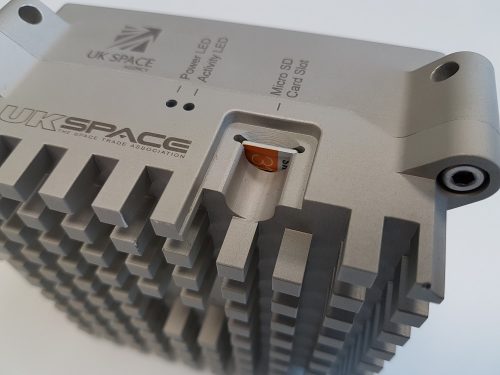
An Astro Pi unit with the new micro SD card installed
The micro SD cards will be flown with a security-hardened version of Raspbian pre-installed.
Crew activities
We have several crew activities planned for when this payload arrives on the ISS. These include the installation of the upgrade items on both Astro Pi units; moving one of the units from Columbus to an earth-facing window (possibly in Node 2); and then moving it back a few weeks later.
Currently it is expected that these activities will be carried out by German ESA astronaut Alexander Gerst who launches to the ISS next year (and will also be the ISS commander for Expedition 57).
Payload launch
We are targeting a January 2018 launch date for the payload. The exact launch vehicle is yet to be determined, but it could be SpaceX CRS 14. We will update you closer to the time.
Questions?
If you have any questions about this payload, how an item works, or why that specific model was chosen, please post them in the comments below, and we’ll try to answer them.


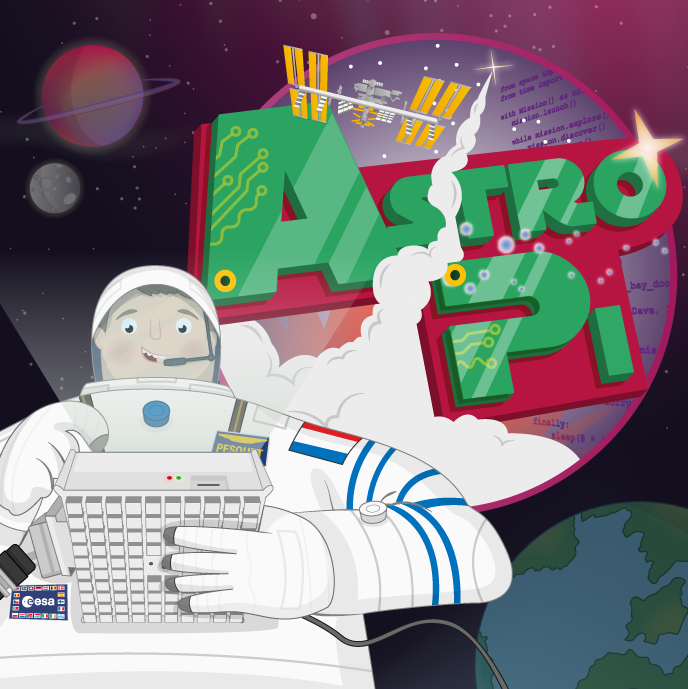



31 comments
Andrew Oakley
Next time someone asks why people still use SSH terminal access instead of VNC remote desktop, we now have the best answer ever. BANDWIDTH IN SPAAAAAAACE!
David Honess — post author
They have a lot of bandwidth to play with, the issue is just latency. Ping time to the Astro Pis is about 700ms which, when you think about what’s going on, is pretty damn fast!
Martin Ellis
Why would the ping be so high?
Will wifi comms be direct to earth with an Adhoc connection or does it connect to a router on-board the ISS and traffic routed through their system. If the latter, then that would account for the high latency.
Simon Thomas
The 700ms round trip time will be more than likely down to one nasa will rate limit the connection to the device on the ISS as satcom bandwidth is not cheap. Two Every hoop you take increases the round trip time and as the Raspberry Pi foundation is a U.K. company to get to the data from ISS will have to come via nasa and there worldwide satcom ground station network as the ISS is in low earth orbit.
Alan Mc (Irish Framboise)
More Pi in Space! Starting to sound strangely “normal” somehow.
Tommy
Where can I by the case?
W. H. Heydt
On a “cost plus profit” basis, you could probably have one made for about $20,000…
tim Rowledge
http://Www.astropicase.com
You can get a kit to add your own Pi/senseHat/buttons to, or a ready-built version with pi3 (to our surprise the wifi works quite well despite the ‘big aluminium box’) and senseHat and the lovely APEM buttons.
Elfen
You can 3D print your own case. I had a friend 3D Print a case for me, and there are mistakes in the “product” but I think I can work with it and finish it in the next month or so.
https://projects.raspberrypi.org/en/projects/astro-pi-flight-case
David Honess — post author
The actual flight CAD is also available here: https://github.com/raspberrypilearning/astro-pi-flight-case/tree/master/data/cnc-milled
Peter Stevens
Fun fact, Diana Probst also designed the rackmount units for the Mythic Beasts Pi Cloud and I was involved in some of the security discussions for Raspbian on the ISS.
Closest I’ve yet managed to being an astronaut – beats out the job at a Jodrell Bank radio telescope.
Diana Probst
SQUEEEEEEEEEEEEEEEEEEEEEEEEEEEEEEEEE!!!!!!!!!!!!!!!!!!!!!!!!!!!!!!!!!!!!!!!
Um, yeah. I’m pretty happy about that.
W. H. Heydt
Is the new version of the OS going to be a download anywhere for those of us who have more or less tried to replicate the AstroPis (complete to using a Model B+)?
David Honess — post author
We are not able to give out the flight OS I’m afraid due to ESA security policy, but it’s basically Jessie Lite (with a few extra customisations).
vince
I’d love to hear more about the ‘security hardened’ aspect and what that means. Is it just custom iptables, or more (what precisely) ? Keeping vanilla raspbian better secured is goodness on the ground too…
Elfen
Interesting, 32GB… why not the max of 64GB? I can guess that 64GB in this “space proof” format does not exist (yet).
It is great to see the Pies up in space gathering data. Hope more are spend. If there was a fund or parts to send for the cause, I can send a few dollars or a Model B+ board for the cause.
Q: Are the Model B+ Astro Pies over-clocked or running at its normal speed?
Elfen
you guys need an Edit Button to correct posted mistakes. But I think you all can read through my typoes.
Bsimmo
The EVO also came in 64 and 128 and it faster EVO Plus also on 256.
David Honess — post author
The chosen size is based on how frequently we can have a downlink window (where we can remote in and copy everything we need down to ground). At the moment these come up weekly, or even more often. If it was any less often than that we would have to go bigger still. We are also looking into getting access to a NASA NAS device which we can push data onto via Samba.
Dinomite59
Can people see the data, from the study?
David Honess — post author
Generally speaking it is down to each individual team to decide if they want to share the data they get back from the ISS. There’s an Astro Pi organisation on GitHub which is the best place to look for this kind of thing. Example here: https://github.com/astro-pi/enviro-pi/tree/master/iss%20downloads
Dirk Broer
When will we see the Raspberry Pi 3 in space? It performs so much better than my B+
Elfen
It’s not the Pi that is the problem but the temperature. The Pi3 runs a lot hotter than a Model B. Even the Pi2 still runs too hot to be sent up to the IIS. And this is at stock speeds.
David Honess — post author
My hope is that we might do a whole new Astro Pi payload for Tim Peake’s next flight which is at least a few years away yet. So it would be whatever version of Pi we’re on at that time.
Elfen
I have been thinking about this for a while. And I would need to confer with those who have a AstroPi replica (metal or plastic) but I have a theory – besides the safety aspect of heat to be dissipated from the R-Pi 2 or R-Pi 3, there is another issue here…
After giving it some thought, my theory is since the Sense Hat in inside the case with the Raspberry Pi, any heat generated by the Raspberry Pi 2 or 3, building up inside the case, would interfere with the Temperature Sensor on the Sense Hat. Thus the Temperature Sensor would never get a proper temperature reading if a R-Pi 2 or R-Pi 3 is used.
As is, I am currently building an AstroPi replica (in Plastic) for my own reason but I will also be testing out this theory with it.
Henrik Melin
What is the Technology Readiness Level (TRL) of the Raspberry Pis on the space station? As this increases one could envisage Pis being used in any number of cool space-flight scenarios, e.g. as controllers in cube-sats. Bringing low-cost computing to space-flight systems – exciting prospects!
David Honess — post author
I would say that Astro Pi payload is TRL level 9, it’s been on board the ISS since 2015 and has completed two missions so far with a third in progress.
Dan Benton
I too would be very interested in the “security-hardened version of Raspbian” that was mentioned in this post.
If it’s good enough for NASA and the ESA I feel it’s good enough for us ;-) :-)
Raspberry Pi Staff Simon Long
The security-hardened version is prepared by an ESA subsidiary purely for use on the ISS, and is not available to the general public.
Dan Benton
Shame, even if the code wasn’t available it would be interesting to know what hardening was being done. There are some great great hardening guides online all to different standards.
Galen
Is there any chance of Raspbian being updated to include a driver for the D-Link WiFi dongle?
I’ve tried building the driver myself, but so far no success, being beyond the skills of this NOOB.